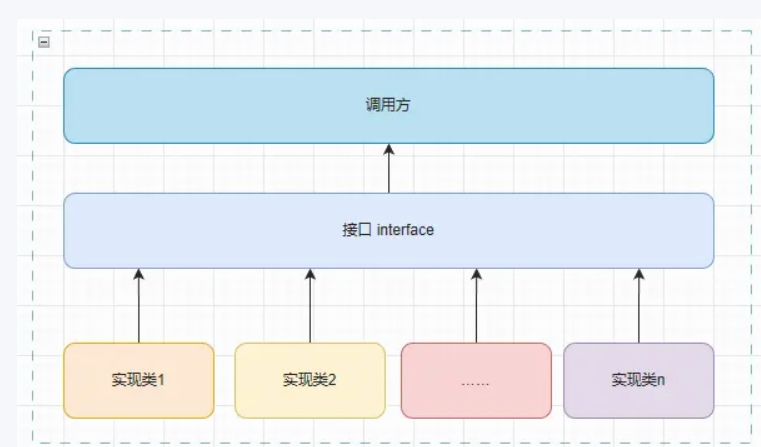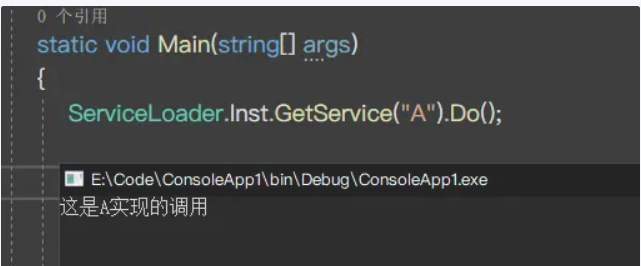接口(interface)可理解为规范、标准、协议。接口是用来约束各方都在同一组规范下工作。电脑外设USB接口,各个品牌商家生产的U盘、鼠标都能够被电脑主板识别并工作,这是因为个生产商都遵循实现了USB接口协议。在编程中接口应用非常广泛,例如IDbConnection接口,这是一组数据库连接的接口,由各个数据库驱动实现,因此.Net可以操作多种数据库。
一套接口多实现的基本结构如下

实现思路是,通过在各实现类上使用Attribute进行标记,然后定义一个实例获取类,通过反射获取所有实现该接口并且标记了的实现类,并将各个实现类通过IOC注册,然后通过标记的类型获取对应的实现类。
接下来是demo演示
定义服务标记
[AttributeUsageAttribute(AttributeTargets.Class, Inherited = false, AllowMultiple = false)]
public class MultiServiceTypeAttribute : Attribute
{
// 堆代码 duidaima.com
public string ServiceType { get; private set; }
public MultiServiceTypeAttribute(string serviceType)
{
ServiceType = serviceType;
}
}
定义接口IMultiInterface
public interface IMultiInterface
{
void Do();
}
定义实现类AMultiInterfaceImplA并标记
[MultiServiceTypeAttribute("A")]
public class MultiInterfaceImplA : IMultiInterface
{
public void Do()
{
Console.WriteLine("这是A实现的调用");
}
}
定义实现类BMultiInterfaceImplB并标记
[MultiServiceTypeAttribute("B")]
public class MultiInterfaceImplB : IMultiInterface
{
public void Do()
{
Console.WriteLine("这是B实现的调用");
}
}
将接口与实现添加到IOC容器,这里使用 Microsoft.Extensions.DependencyInjection.dll和Microsoft.Extensions.DependencyInjection.Abstractions.dll两个库来实现简易IOC容器
public class ServiceLoader
{
private readonly ServiceCollection __ioc = new ServiceCollection();
private ServiceProvider __iocServiceProvider;
private static object _lock = new object();
private static ServiceLoader _inst;
public static ServiceLoader Inst
{
get
{
if (_inst == null)
{
lock (_lock)
{
if (_inst == null)
{
_inst = new ServiceLoader();
_inst.Init();
}
}
}
return _inst;
}
}
private void Init()
{
var tps = typeof(IMultiInterface).Assembly.GetTypes().Where(x =>
x.GetInterfaces().Any(_ => _.Name == nameof(IMultiInterface)));
foreach (var item in tps)
{
if (item.IsClass)
{
Inst.AddTransient(typeof(IMultiInterface), item);
}
}
Interlocked.Exchange(ref __iocServiceProvider, Inst.__ioc.BuildServiceProvider());
}
private void AddTransient(Type iface, Type impl)
{
__ioc.AddTransient(iface, impl);
}
}
根据标记的类型获取对应的接口实现。在ServiceLoader中继续添加以下方法
public IMultiInterface GetService(string serviceType)
{
var svcList = __iocServiceProvider.GetServices<IMultiInterface>();
var svc = svcList.FirstOrDefault(x => x.GetType().GetCustomAttribute<MultiServiceTypeAttribute>()?.ServiceType == serviceType);
if (svc == null)
{
//Console.WriteLine($@"未找到 {serviceType} 服务实现,使用默认实现");
// 如果有默认实现类,这里可选择调用默认实现
//svc = svcList.FirstOrDefault(x => x.GetType().GetCustomAttribute<MultiServiceTypeAttribute>()?.ServiceType == "__default__");
throw new Exception($"未找到 {serviceType} 服务实现");
}
return svc;
}
通过ServiceLoader.Inst.GetService("serviceType").Do();来获取对应的接口实例,入参就是各个实现类上标记的类型,并调用接口。
调用示例如下

至此实现了一接口多实现的雏形。
 闽公网安备 35020302035485号
闽公网安备 35020302035485号
 闽公网安备 35020302035485号
闽公网安备 35020302035485号

